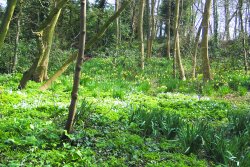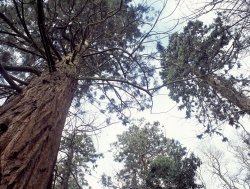|
Early History
Ridge House
The Gardens
Ridge Families
Topography
Maps
Time Tour
Picture Gallery
|
|
 |
| |
Ridge Wood - The Gardens
Those who inhabited Ridge House during the early 19th century were farmers. Much of the land they farmed has now disappeared because of quarrying so it is difficult to visualise the countryside that they knew.
It is likely though, that Ridge Wood was not so extensive as it is now. To the south, stands an area of what is likely to be ancient woodland but the remainder may have been dominated by agriculture and the pleasure gardens belonging to the house. The latter took the form of a shady woodland garden, enhance by terraced lawns and glass houses.
 The woods were also unlikely to have been so dense when the now-demolished house was occupied. Anybody who has observed a neglected patch of land over the years will observe that it only takes a little time for saplings to invade and a brand-new woodland to appear. And as bluebells and other native woodland flowers can be found throughout Ridge Wood, it seems that the plants that occupied the small area of ancient woodland were able to spread into the area surrounding them when it was no longer used for farming. Either that, or they were encouraged by human agents. The woods were also unlikely to have been so dense when the now-demolished house was occupied. Anybody who has observed a neglected patch of land over the years will observe that it only takes a little time for saplings to invade and a brand-new woodland to appear. And as bluebells and other native woodland flowers can be found throughout Ridge Wood, it seems that the plants that occupied the small area of ancient woodland were able to spread into the area surrounding them when it was no longer used for farming. Either that, or they were encouraged by human agents.
The pleasure gardens are noted from at least as far back as 1830. Perhaps the most dominant trees in their midst are the huge Sequoiadendron giganteum (Wellingtonias) that tower above the canopy. A study of their history may throw some light on the main era of planting in these gardens.
 The Parkland TreesAlso known as the giant sequoia (Sequoiadendron giganteum), this species originates from the western slopes of the Sierra Nevada mountain range which runs down the eastern side of California. They were first properly described in 1853 (though it is likely that the first Europeans to come across the Wellingtonias were actually members of Captain Joseph R Walker's party which travelled through this mountain range in 1833). This was the era of the great movement westward across America which is remembered as the Gold Rush. Shortly after their discovery, they were introduced into Britain. The first plantations were established in Hampshire in 1857, on the estate belonging to the Duke of Wellington - which explains the tree's popular name. It swiftly became a fashionable plant for large estates and specimens were planted across the country, all within a short space of time. Many were brought to this country on the S S Great Britain. They responded favourably to their new environment and, within 90 years were being recorded across the country as the largest trees in the landscape. And they had staying power. They rarely blew down during high winds. Their great height did make them vulnerable to lightning strikes but such attacks did not destroy them. They would just continue to grow with a slightly altered profile.
They are covered with a thick, spongy bark which helps to protect them from fire - a definite asset in their hot, dry Californian homeland. This bark has proved to be beneficial to our native wildlife. Tree creepers find it the perfect place to create cavities for their nests.
A tree recently felled in Ridge Wood appears, by a count of its rings, to have been planted during the latter years of the 19th century. The time when this plant was introduced to this country tallies with this and strongly suggests that it was the Burges family who were responsible for the establishment of the species in this area.
If you stand at a high, open point in Ridge Wood, and gaze across Yate, you will see other specimens of Wellingtonia, at much the same stage of maturity. They are particularly numerous in the area close to the parish church. Pictures of the previously-mentioned old rectory (which for a time was known as Poole Court although it was not the same building as the one we know today), reveal that these trees stood in what were obviously beautifully landscaped grounds. Like Ridge House, it was adorned with terraced lawns so it is possible that there is a link between the establishment of both these gardens. Wellingtonia trees also grace the grounds of The Lawns which stands on the road approaching the parish church.
Other ornamental trees grace Ridge Wood for the delight of the observant visitor. Conifers include the dramatic Deodar Cedar which was introduced into this country in 1831 and the Corsican Pine. Amongst the deciduous trees that have been established, can be found hornbeam, poplar and common lime.
 Around the LodgeThe Lodge is a beautiful timbered building that stands opposite the Ridgewood Centre. It once guarded the entrance to the grounds of Ridge House. It was built in 1883 following a trip that Colonel Burges made to Switzerland. Whilst there, he developed a fondness for the cottages that embellished that landscape and decided to create something similar on his own land.
Huge Wellingtonia trees still stand sentry beside it. At one time, an avenue of walnut trees flanked the drive that led from here to the house itself. Fragments of this avenue still remain for those who like a little exploration.
To find them, it is necessary to walk behind the crescent of shops on the Ridge housing estate and continue past the primary schools that stand nearby. You will then reach a small area of open space, known as Howard Lewis Park which was named after the magistrate and long-serving first Head Teacher of The Ridge Junior School. An avenue of walnuts passes through this place, providing welcome shade in the summer.
At the other end of the park, it is possible to see other specimens in Firgrove Crescent and Melrose Avenue, until you reach one of the footpaths leading into the wood, where one still borders the entrance. It is possible to visualise the sweeping line that the complete avenue of these trees must have made as they climbed to the entrance of the house.
At a lower level, there are other plants of interest to the visitor. Not all of these are entirely welcome. Dwarf bamboo, originally planted as an attractive shrub, has proved invasive. Its ability to spread rapidly by tenacious underground means has made it a threat to the more delicate flora that inhabits the wood. For the well-being of the ecosystem that exists in this place, it is necessary to remove stands of this plant from time to time.
 When and what to visitBut perhaps the best time of year to visit a place like Ridge Wood is the spring. The native woodland flowers, such as bluebells, anemones, campion, stitchwort and moschatel have already been noted but in addition to these, there are sheets of planted bulbs which create a breathtaking spectacle of colour between March and May. The best place to see them is where the public footpath leads you close to the summit of the ridge, close to where the house once stood and where Hanson now has its headquarters.
This is a mysterious place where an ornamental standing stone guards the woodland floor. It was probably erected as part of the landscaping of the pleasure gardens but perhaps the choice of its location is significant, for it stands close to the site of the Iron Age camp. In this area, it is also possible to see remnants of the terracing which was necessary for a garden on such a hilly site. In the spring, this area is dominated by colourful flowers such as Anenome in beautiful shades of mauve, blue and white.
At one time, the driveway to the house was flanked by regiments of daffodils, all nodding respectfully as vehicles passed by.
The terraced lawns close to the house were interconnected with sweeps of elegant stone stairways, rather similar to the steps that can still be seen embellishing the lawns of Ashton Court Mansion today. The steep slopes between the lawns were planted with a lush variety of attractive shrubs and herbaceous plants.
At one time, the Field family served as the gardeners to Ridge House, dwelling in the already mentioned Swiss-style lodge. Ernest Field, the son of the gardener, wrote an article about his experiences there. In it, he describes a conservatory, an orchid house and a vinery - this was obviously a high-maintenance garden!
As you wander around Ridge Wood today, the limestone faces that are occasionally encountered still suggest an ornamental garden which made the most of the underlying terrain. And next to Hanson's headquarters, a Japanese maple grows which was planted in that original garden. Much has vanished with the passing of time, but hidden beneath the deep shade of the trees it is still possible to discern a little of what lay here in the past.
Thanks to Sharon Eubank
Return to top of page
|
|
| |
|

